Monster Hunter Wilds is a good looking game, but its console iterations aren’t perfect. The base PlayStation 5 and Xbox Series X pack a lot of visual modes, but suffer from substantial image quality and performance woes while lacking the PC version’s higher-end settings. Sony’s PS5 Pro, though, should carry an antidote for these afflictions – with PSSR and ray tracing in the mix. Does Sony’s enhanced machine comprehensively address Wilds’ console failings then, or is there a deeper root cause?
The game’s 60fps frame-rate mode is the most exciting option on PS5 Pro for me, because the turnout on the base PS5 wasn’t great. The game suffered from excessive aliasing and image breakup, a consequence of relying on a pretty weak anti-aliasing solution with a crude mix of spatial upscaling and sharpening to make it look more refined on a 4K set. Internally, we were looking at resolutions from about 720p to 1080p with dynamic resolution scaling, but the system lacked the customary temporal upsampling process that can make a low-resolution render look decent on high-resolution displays.
PS5 Pro brings that upsampling to bear here, with an implementation of Sony’s PSSR upscaler – and the results are much improved, even in stills. The Pro is much more temporally stable relative to the base console, without the ugly stair-stepping artefacts that we saw on PS5. In scenes with a lot of dense geometry, the Pro resolves a much cleaner image that holds up well. Oddly, the base PS5 actually has an edge in terms of overall image sharpness, thanks to its post-process sharpening, but the fundamentals of the image are much stronger on Pro.
When we actually move through the game world, though, the differences are more stark. Here, the PS5 really struggles to resolve anything approaching a clean image, with constant and shifting stair-stepping geometry and flickering foliage. The Pro is far more pristine in comparison, resolving a smooth (if soft) image.
In terms of the raw rendering metrics, we’re looking at a 1080p internal resolution on PS5 Pro with PSSR. Dynamic resolution scaling is possible, but I didn’t spot it in my testing. It’s also interesting that there are no clear signs of upscaling here, as you’d normally expect PSSR to resolve to a 4K image – but here it looks quite soft and 1080p-like. That leads me to suggest it might be a use case somewhat analagous to “DLAA” on Nvidia PC graphics cards – using super resolution for anti-aliasing only. It’s not too bad in comparison to the base console, but a ways away from the 4K 60fps dream of the PS5 Pro.
The Pro also does a better job of hitting a stable 60fps than the base console. It’s still not a perfect 60, but dips are infrequent and not very impactful to gameplay in comparison to PS5. Unlocking the frame-rate with a 120Hz display allows for higher frame-rates, typically 60-80fps. If you have VRR on, it’s worth trying, though I’d probably still rather opt for the 60fps cap.
Unfortunately, in frame-rate mode we still get the usual RE Engine screen space reflections (SSR) on bodies of water, which looks artefact-ridden and prone to obvious occlusion issues. That is solved in the resolution mode on PS5 Pro, which uses more accurate RT reflections that allow you to see elements that are completely off-screen. The SSR looks low-res and muddy by comparison, struggling to create convincing-looking reflections.
The RT reflections do have certain flaws, though. They can suffer from quite a bit of breakup when you move through a scene, with less-than-ideal denoising and obviously limited resolution. You can notice substantial pop-in in the reflections as you move forward, which can be a bit distracting. The volumetric lighting in the scene isn’t really approximated effectively within the ray tracing either, which can make the reflections look a bit incorrect at times. Still, I think it’s a major improvement over the SSR on PS5, and it represents a clear visual win for the Pro console.
Beyond any RT concerns, image quality is also generally better on Pro. PSSR cleans up flickering foliage better than the TAA in use on PS5, especially during movement. Aliasing is generally less of a concern as well, with a smoother, more refined presentation of art assets. The image is slightly softer than the picture on the base console, but I would give the nod to Pro overall – and it looks sharp enough from a normal viewing distance.
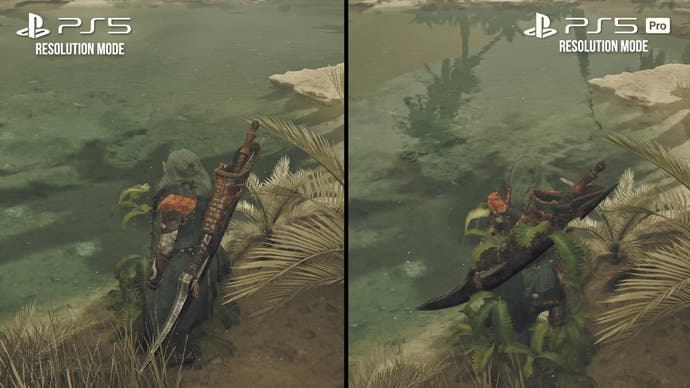
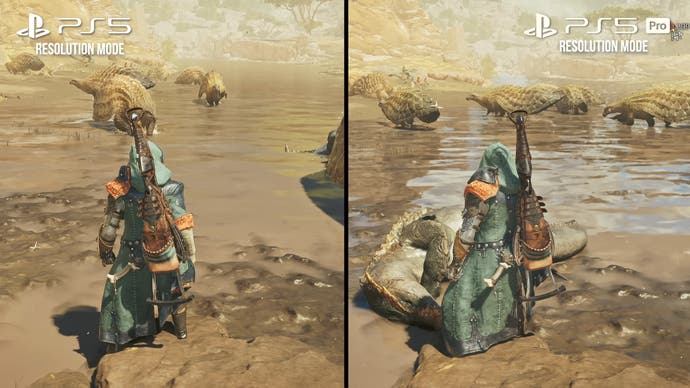
In terms of internal resolution, the raw numbers from Capcom suggest a 1728p pixel count, though my own counts are a bit higher – typically 1944p – with dynamic resolution causing some variation. Performance is generally fine enough, with a 30fps reading through most content, but there are more frequent frame-drops than on the base PS5 in content like fast traversal or demanding combat encounters. Unlocked, performance between about 30fps and 45fps is typical.
Finally, there’s the balanced mode. As its name implies, this strikes a middle ground between the other two mode options, with a 40fps frame-rate target. New here is the introduction of ray traced reflections, just like the resolution mode, which are a nice bonus. Image quality again is superior to PS5, with a cleaner look overall and perhaps just a touch less sharpness. PSSR does a more effective job of addressing stair-stepping, shimmering, and other visual gremlins from the base console.
Capcom reports this mode as using a 1404p internal resolution, which aligns with my own testing, though DRS can take it lower or quite a lot higher depending on the circumstances. Performance is again OK, but with small dips with the usual fast traversal or combat triggers. It’s a pretty similar turnout to the PS5’s balanced mode, which has similar issues. Unlocked, the game really likes to stay pegged close to 40fps, which is perhaps a sign that the DRS system is still working hard during unlocked play.
As a final note, just like PS5, 120Hz output with VRR doesn’t engage LFC with this title for the balanced or resolution modes, so it feels choppier than it should, especially when uncapped. Only the frame-rate mode can really get the full benefit from VRR.
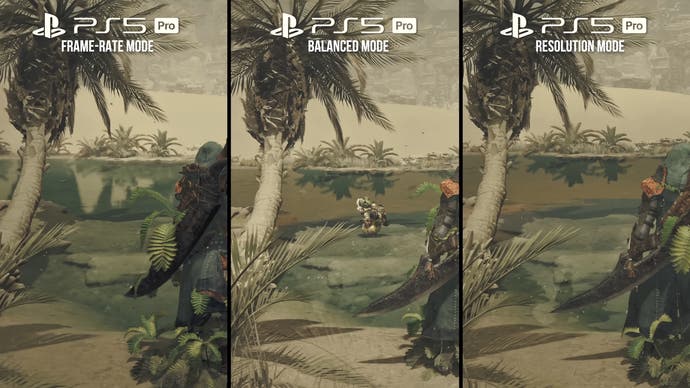
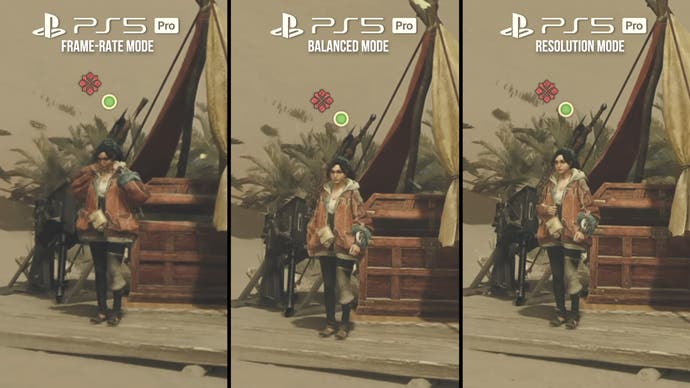
If we stack the three key modes here against each other, the most obvious difference comes down to image quality, with a soft frame-rate mode and increasingly sharper and detailed results at balanced and resolution. None of the modes suffer from excessive edge aliasing or flicker, but the two lower-performing modes do hold up better on a 4K pixel grid.
The other obvious concession lies in reflections on bodies of water, where the resolution and balanced modes enjoy similar-looking RT reflections, and the frame-rate mode is left to settle for SSR instead. Some areas are pretty arid and don’t really see much benefit, while others have more extensive water features and do look much better with the RT reflections. Outside of those two areas, the same little tweaks present between the PS5 modes are also present here. Volumetric lighting quality is worse in the frame-rate mode, LODs are pulled in and GI quality takes a small hit as well. Generally though, the key points of differentiation are those image quality and reflection changes.
Overall, I like the frame-rate mode now, as the relatively weak motion blur requires a higher frame-rate for smooth results. Balanced mode is also a strong contender, with a noticeable boost to sharpness while still feeling OK in performance terms. Resolution mode doesn’t offer a big enough boost in clarity to make the degradation to responsiveness feel worthwhile. It’d be easier to recommend these latter two modes if Capcom fixes the LFC issue affecting them.
Ultimately, I think Monster Hunter Wilds’ PS5 Pro boosts are very welcome. The game looks a lot better than the base console, with visuals that get both image quality and feature level enhancements. If I had any critique in particular, it’s that Wilds is quite a heavy title generally, so the Pro boosts don’t really bring it up to the same level as other comparable titles. In its best moments, the Pro can elevate PS5 software to have credible 4K60 imagery or transformative ray tracing, and that isn’t the case here. Instead, we get image quality and performance pairings that a lot of players would have reasonably expected from the base PS5, with a 1080p60-like frame-rate mode and two lower performance modes with better image quality and limited RT.
fbq('init', '560747571485047');
fbq('track', 'PageView'); window.facebookPixelsDone = true;
window.dispatchEvent(new Event('BrockmanFacebookPixelsEnabled')); }
window.addEventListener('BrockmanTargetingCookiesAllowed', appendFacebookPixels);
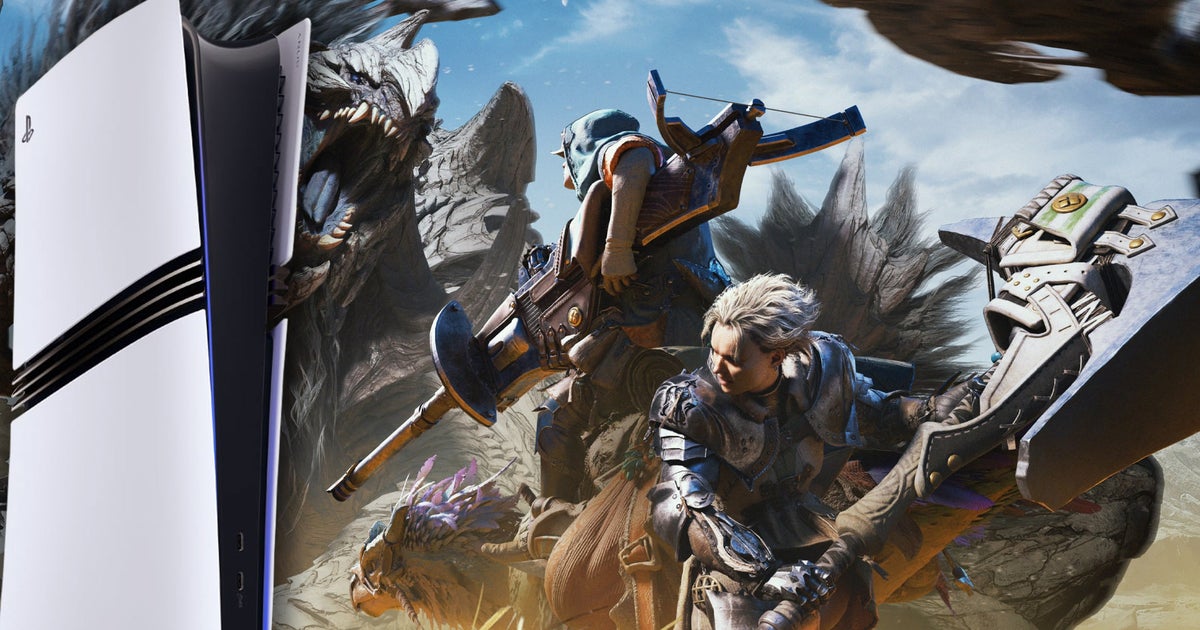










Leave a Reply